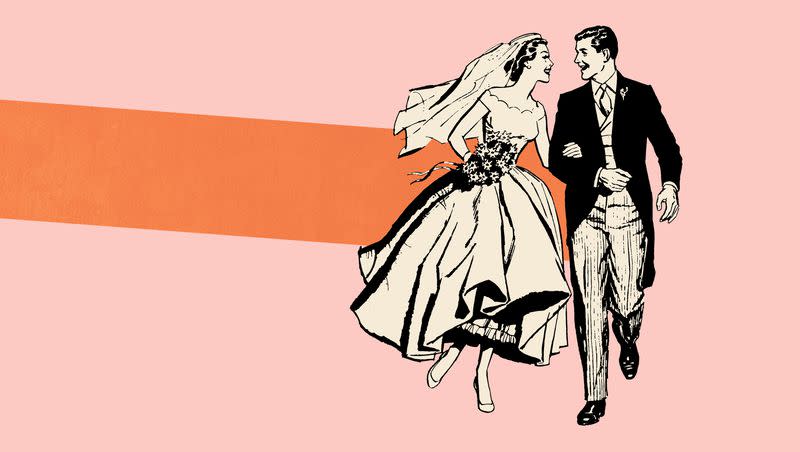Perspective: Bring back ‘happily ever after’ in the movies

Against my better judgment, a few weeks ago I took my kids to see Disney’s recent release, “Wish.” I had seen the reviews, and thus expected the movie would be a boring flop. It lived up — or, well, down — to my expectations. On the drive home, none of us could recall any of the forgettable songs. That alone should be grounds for a refund to any film purporting to channel the Disney classics’ magic, as this one (unsubtly and unartfully) does.
My 6-year-old son, though, had a more plot-related question: “Mom, why doesn’t Asha (the protagonist) marry anyone?”
Why, indeed?
In “Wish,” as in both of Disney’s other original animated features of the past decade — “Moana” (2016) and “Encanto” (2021) — the female heroine both begins and ends the movie sans a romantic partner. Although the idiosyncratic humor of “Moana” and the infectious tunes of “Encanto” make these films highly watchable, it is an accurate reflection of today’s social and political climate that each film’s plot turns on the pursuit of collective restitution for past injustices rather than on the pursuit of individual ambition for the future.
Thus, the decadence, depression and cultural decline reflected in — and constitutive of —today’s falling rates of marriage are reinforced in Disney’s latest coming-of-age stories, which attempt to celebrate women’s independence by departing from the hegemony of “happily ever after.”
That is, today’s ostensibly virtuous stories do not presume the establishment of a marital relationship as an inextricable part of building an adult life — in deference to a trendy understanding of feminism that is not serving our society any better than it does these sub-par films.
The early Disney classics, in contrast, were awash in altar-bound princesses, and they entrenched “Prince Charming” as part of the popular lexicon. And, yes, many of those films mightily and regressively overdid it. One need not claim mainstream feminism, for example, to cringe at the plotline that has the passive and nubile “Sleeping Beauty” (1959) saved — awakened to life itself — only by a prince’s kiss.
Even 30 years later, things were not much better. I was head over heels for “The Little Mermaid” as a preschooler in 1989, but Ariel isn’t much of a heroine. Though she displays individual ambition and agency of a sort, she ultimately gives up her life, her family and her literal voice in uncertain pursuit of a guy she’s barely met.
Yet, for more than 20 years — from “Beauty and the Beast” (1991) all the way up through “Frozen” (2013) — Disney got “happily ever after” mostly right.
Related
Belle spurns Gaston, the allegedly handsome epitome of so-called toxic masculinity; saves her father; and gets the adventure she longs for. Mulan (1998) refuses to conform to the hyper-feminine standards of imperial China, works twice as hard and twice as smart as her male counterparts in the army to compensate for her physical shortcomings, and saves both her father and her country. Tiana of “The Princess and the Frog” (2009) embodies determination and ambition, working two jobs to achieve her dream of owning a fine New Orleans restaurant; inspires her prospective beau to abandon extended adolescence and grow up enough to be worthy of her; and lives out, as a woman, her father’s professional objective and legacy.
Each of these protagonists of yore has not only a driving ambition for her own future, but a compelling personality conducive to the viewer’s interest in her character development over the course of each film. These are not one-dimensional, passive vessels like “Sleeping Beauty,” for whom marriage is a bland and necessary sole achievement. But neither are they one-dimensional, empty vessels like Asha, for whom thinking beyond collective restitution for some past wrong is an impossibility.
On the contrary, Belle, Mulan and Tiana are vibrant, active agents, for whom the future-oriented establishment of a romantic partnership is not the sum total of — but is inextricable from — the fulfillment of their broadest ambitions. In this way, they reflect an optimization between the fruits of women’s empowerment and the endurance of the family as the foundation of society.
Isn’t that what we want for our daughters? And for our sons, for that matter?
Given the known benefits of marriage, I know I do.
The last time he watched “Mulan,” my 6-year-old son told me that he hopes to marry a girl like her when he grows up. My hope is that he continues to believe that marriage and growing up go together. And my wish is that Hollywood return to reinforcing that idea.
Elizabeth Grace Matthew is a visiting fellow at Independent Women’s Forum, a Young Voices contributor and a regular opinion contributor at The Hill.

